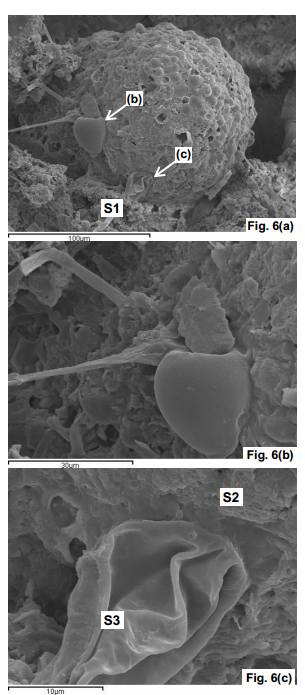Astrobiologists Find Ancient Fossils in Fireball Fragments
Algae-like structures inside a Sri Lankan meteorite are clear evidence of panspermia, the idea that life exists throughout the universe, say astrobiologists.

On 29 December 2012, a fireball lit up the early evening skies over the Sri Lankan province of Polonnaruwa. Hot, sparkling fragments of the fireball rained down across the countryside and witnesses reported the strong odour of tar or asphalt.
Over the next few days, the local police gathered numerous examples of these stones and sent them to the Sri Lankan Medical Research Institute of the Ministry of Health in Colombo. After noticing curious features inside these stones, officials forwarded the samples to a team of astrobiologists at Cardiff University in the UK for further analysis.
The results of these tests, which the Cardiff team reveal today, are extraordinary. They say the stones contain fossilised biological structures fused into the rock matrix and that their tests clearly rule out the possibility of terrestrial contamination.
In total, Jamie Wallis at Cardiff University and a few buddies received 628 stone fragments collected from rice fields in the region. However, they were able to clearly identify only three as possible meteorites.
The general properties of these three stones immediately mark them out as unusual. One stone, for example, had a density of less than 1 gram per cubic centimetre, less than all known carbonaceous meteorites. It had a partially fused crust, good evidence of atmospheric heating, a carbon content of up to 4 per cent and contained an abundance of organic compounds with a high molecular weight, which is not unknown in meteorites. On this evidence, Wallis and co think the fireball was probably a small comet.
The most startling claims, however, are based on electron microscope images of structures within the stones (see above). Wallis and co. say that one image shows a complex, thick-walled, carbon-rich microfossil about 100 micrometres across that bares similarities with a group of largely extinct marine dinoflagellate algae.
They say another image shows well-preserved flagella that are 2 micrometres in diameter and 100 micrometres long. By terrestrial standards, that’s extremely long and thin, which Wallis and co. interpret as evidence of formation in a low-gravity, low-pressure environment.
Wallis and co. also measured the abundance of various elements in the samples to determine their origin. They say that low levels of nitrogen in particular rule out the possibility of contamination by modern organisms which would have a much higher nitrogen content. The fact that these samples are also buried within the rock matrix is further evidence, they say.
Wallis and co. are convinced that the lines of evidence they have gathered are powerful and persuasive. “This provides clear and convincing evidence that these obviously ancient remains of extinct marine algae found embedded in the Polonnaruwa meteorite are indigenous to the stones and not the result of post-arrival microbial contaminants,” they conclude.
There’s no question that a claim of this kind is likely to generate controversy. Critics have already pointed out that the stones could have been formed by lightning strikes on Earth although Wallis and co. counter by saying there was no evidence of lightning at the time of the fireball and that in any case, the stones do not bear the usual characteristics of this kind of strike. What’s more, the temperatures generated by lightning would have destroyed any biological content.
Nevertheless, extraordinary claims require extraordinary evidence and Wallis and co. will need to make their samples and evidence available to the scientific community for further study before the claims will be taken seriously.
If the paper is taken at face value, one obvious question that arises is where these samples came from. Wallis and c.o have their own ideas: “The presence of fossilized biological structures provides compelling evidence in support of the theory of cometary panspermia first proposed over thirty years ago,” they say.
This is an idea put forward by Fred Hoyle and Chandra Wickramasinghe, the latter being a member of the team who has carried out this analysis.
There are other explanations, of course. One is that the fireball was of terrestrial origin, a remnant of one of the many asteroid impacts in Earth’s history that that have ejected billions of tonnes of rock and water into space, presumably with biological material inside. Another is that the structures are not biological and have a different explanation.
Either way, considerably more work will have to be done before the claims from this team can be broadly accepted. Exciting times ahead!Ref: arxiv.org/abs/1303.1845: The Polonnaruwa Meteorite: Oxygen isotope, Crystalline and Biological Composition
What a material of un-ambiguity and preserveness of valuable familiarity about unpredicted
ReplyDeletefeelings.
My webpage; http://2013raybanfreeshipping.com
Hi there, You've done a great job. I will certainly digg it and personally recommend to my friends. I am confident they'll be benefited from this site.
ReplyDeletemy web blog; オークリー サングラス
supreme t shirt
ReplyDeleteair max 97
michael kors handbags
lebron james shoes
cheap mlb jerseys
retro jordans
air max 270
nike air max 95
huaraches
nike shoes
replica bags s41 r0s89n1j13 bags replica gucci g03 f0o38m4k04 buy replica bags v94 v1h65l8b15
ReplyDelete